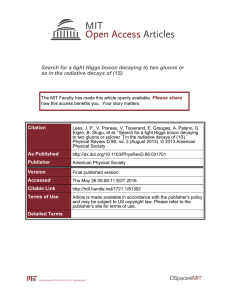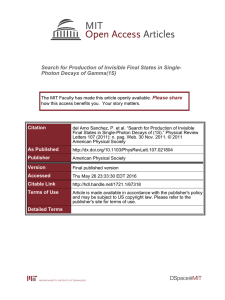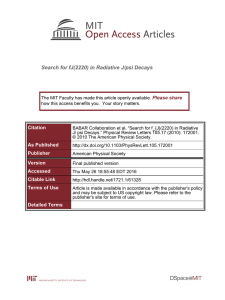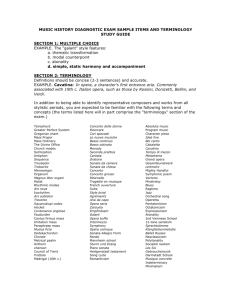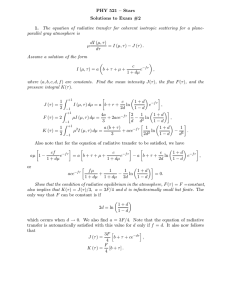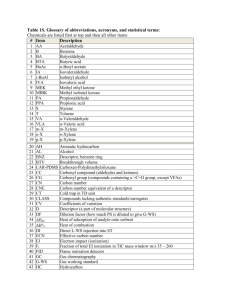Search for Hadronic Decays of a Light Higgs Boson in... Radiative Decay A Please share
advertisement
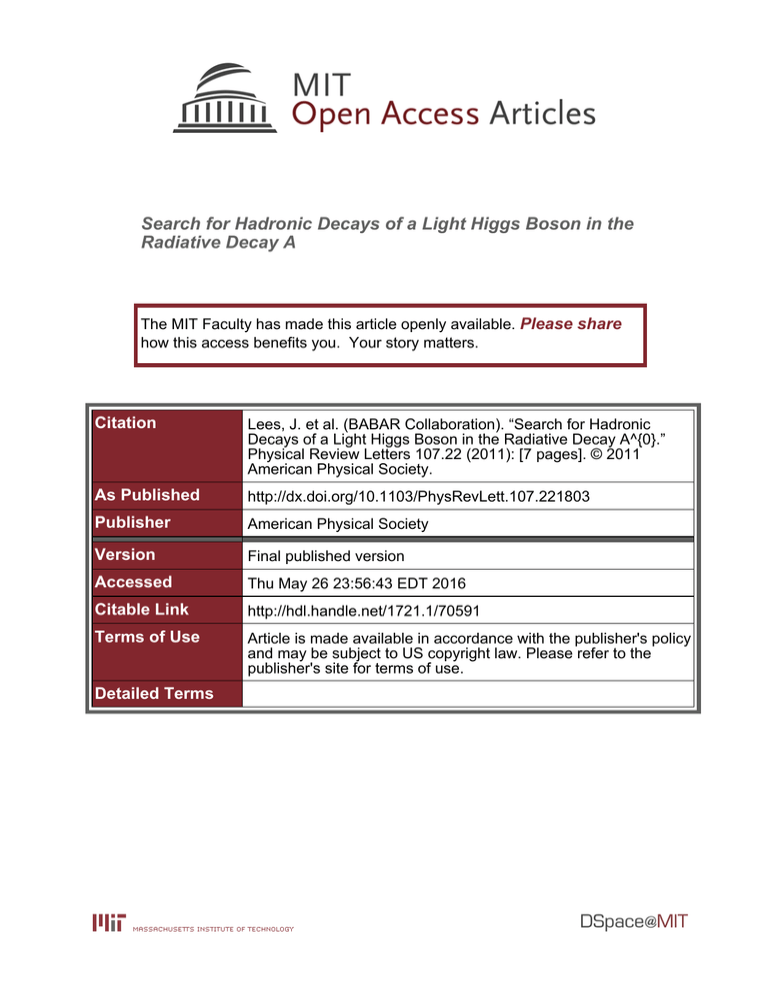
Search for Hadronic Decays of a Light Higgs Boson in the
Radiative Decay A
The MIT Faculty has made this article openly available. Please share
how this access benefits you. Your story matters.
Citation
Lees, J. et al. (BABAR Collaboration). “Search for Hadronic
Decays of a Light Higgs Boson in the Radiative Decay A^{0}.”
Physical Review Letters 107.22 (2011): [7 pages]. © 2011
American Physical Society.
As Published
http://dx.doi.org/10.1103/PhysRevLett.107.221803
Publisher
American Physical Society
Version
Final published version
Accessed
Thu May 26 23:56:43 EDT 2016
Citable Link
http://hdl.handle.net/1721.1/70591
Terms of Use
Article is made available in accordance with the publisher's policy
and may be subject to US copyright law. Please refer to the
publisher's site for terms of use.
Detailed Terms
PRL 107, 221803 (2011)
PHYSICAL REVIEW LETTERS
week ending
25 NOVEMBER 2011
Search for Hadronic Decays of a Light Higgs Boson in the Radiative Decay ! A0
J. P. Lees,1 V. Poireau,1 V. Tisserand,1 J. Garra Tico,2 E. Grauges,2 M. Martinelli,3a,3b D. A. Milanes,3a A. Palano,3a,3b
M. Pappagallo,3a,3b G. Eigen,4 B. Stugu,4 D. N. Brown,5 L. T. Kerth,5 Yu. G. Kolomensky,5 G. Lynch,5 H. Koch,6
T. Schroeder,6 D. J. Asgeirsson,7 C. Hearty,7 T. S. Mattison,7 J. A. McKenna,7 R. Y. So,7 A. Khan,8 V. E. Blinov,9
A. R. Buzykaev,9 V. P. Druzhinin,9 V. B. Golubev,9 E. A. Kravchenko,9 A. P. Onuchin,9 S. I. Serednyakov,9 Yu. I. Skovpen,9
E. P. Solodov,9 K. Yu. Todyshev,9 A. N. Yushkov,9 M. Bondioli,10 D. Kirkby,10 A. J. Lankford,10 M. Mandelkern,10
D. P. Stoker,10 H. Atmacan,11 J. W. Gary,11 F. Liu,11 O. Long,11 G. M. Vitug,11 C. Campagnari,12 T. M. Hong,12
D. Kovalskyi,12 J. D. Richman,12 C. A. West,12 A. M. Eisner,13 J. Kroseberg,13 W. S. Lockman,13 A. J. Martinez,13
T. Schalk,13 B. A. Schumm,13 A. Seiden,13 C. H. Cheng,14 D. A. Doll,14 B. Echenard,14 K. T. Flood,14 D. G. Hitlin,14
P. Ongmongkolkul,14 F. C. Porter,14 A. Y. Rakitin,14 R. Andreassen,15 M. S. Dubrovin,15 Z. Huard,15 B. T. Meadows,15
M. D. Sokoloff,15 L. Sun,15 P. C. Bloom,16 W. T. Ford,16 A. Gaz,16 M. Nagel,16 U. Nauenberg,16 J. G. Smith,16
S. R. Wagner,16 R. Ayad,17,* W. H. Toki,17 B. Spaan,18 M. J. Kobel,19 K. R. Schubert,19 R. Schwierz,19 D. Bernard,20
M. Verderi,20 P. J. Clark,21 S. Playfer,21 D. Bettoni,22a C. Bozzi,22a R. Calabrese,22a,22b G. Cibinetto,22a,22b
E. Fioravanti,22a,22b I. Garzia,22a,22b E. Luppi,22a,22b M. Munerato,22a,22b M. Negrini,22a,22b L. Piemontese,22a V. Santoro,22a
R. Baldini-Ferroli,23 A. Calcaterra,23 R. de Sangro,23 G. Finocchiaro,23 M. Nicolaci,23 P. Patteri,23 I. M. Peruzzi,23,†
M. Piccolo,23 M. Rama,23 A. Zallo,23 R. Contri,24a,24b E. Guido,24a,24b M. Lo Vetere,24a,24b M. R. Monge,24a,24b
S. Passaggio,24a C. Patrignani,24a,24b E. Robutti,24a B. Bhuyan,25 V. Prasad,25 C. L. Lee,26 M. Morii,26 A. J. Edwards,27
A. Adametz,28 J. Marks,28 U. Uwer,28 F. U. Bernlochner,29 M. Ebert,29 H. M. Lacker,29 T. Lueck,29 P. D. Dauncey,30
M. Tibbetts,30 P. K. Behera,31 U. Mallik,31 C. Chen,32 J. Cochran,32 W. T. Meyer,32 S. Prell,32 E. I. Rosenberg,32
A. E. Rubin,32 A. V. Gritsan,33 Z. J. Guo,33 N. Arnaud,34 M. Davier,34 G. Grosdidier,34 F. Le Diberder,34 A. M. Lutz,34
B. Malaescu,34 P. Roudeau,34 M. H. Schune,34 A. Stocchi,34 G. Wormser,34 D. J. Lange,35 D. M. Wright,35 I. Bingham,36
C. A. Chavez,36 J. P. Coleman,36 J. R. Fry,36 E. Gabathuler,36 D. E. Hutchcroft,36 D. J. Payne,36 C. Touramanis,36
A. J. Bevan,37 F. Di Lodovico,37 R. Sacco,37 M. Sigamani,37 G. Cowan,38 D. N. Brown,39 C. L. Davis,39 A. G. Denig,40
M. Fritsch,40 W. Gradl,40 A. Hafner,40 E. Prencipe,40 K. E. Alwyn,41 D. Bailey,41 R. J. Barlow,41,‡ G. Jackson,41
G. D. Lafferty,41 E. Behn,42 R. Cenci,42 B. Hamilton,42 A. Jawahery,42 D. A. Roberts,42 G. Simi,42 C. Dallapiccola,43
R. Cowan,44 D. Dujmic,44 G. Sciolla,44 D. Lindemann,45 P. M. Patel,45 S. H. Robertson,45 M. Schram,45 P. Biassoni,46a,46b
A. Lazzaro,46a,46b V. Lombardo,46a N. Neri,46a,46b F. Palombo,46a,46b S. Stracka,46a,46b L. Cremaldi,47 R. Godang,47,§
R. Kroeger,47 P. Sonnek,47 D. J. Summers,47 X. Nguyen,48 P. Taras,48 G. De Nardo,49a,49b D. Monorchio,49a,49b
G. Onorato,49a,49b C. Sciacca,49a,49b G. Raven,50 H. L. Snoek,50 C. P. Jessop,51 K. J. Knoepfel,51 J. M. LoSecco,51
W. F. Wang,51 K. Honscheid,52 R. Kass,52 J. Brau,53 R. Frey,53 N. B. Sinev,53 D. Strom,53 E. Torrence,53 E. Feltresi,54a,54b
N. Gagliardi,54a,54b M. Margoni,54a,54b M. Morandin,54a M. Posocco,54a M. Rotondo,54a F. Simonetto,54a,54b
R. Stroili,54a,54b S. Akar,55 E. Ben-Haim,55 M. Bomben,55 G. R. Bonneaud,55 H. Briand,55 G. Calderini,55 J. Chauveau,55
O. Hamon,55 Ph. Leruste,55 G. Marchiori,55 J. Ocariz,55 S. Sitt,55 M. Biasini,56a,56b E. Manoni,56a,56b S. Pacetti,56a,56b
A. Rossi,56a,56b C. Angelini,57a,57b G. Batignani,57a,57b S. Bettarini,57a,57b M. Carpinelli,57a,57b,k G. Casarosa,57a,57b
A. Cervelli,57a,57b F. Forti,57a,57b M. A. Giorgi,57a,57b A. Lusiani,57a,57c B. Oberhof,57a,57b E. Paoloni,57a,57b A. Perez,57a
G. Rizzo,57a,57b J. J. Walsh,57a D. Lopes Pegna,58 C. Lu,58 J. Olsen,58 A. J. S. Smith,58 A. V. Telnov,58 F. Anulli,59a
G. Cavoto,59a R. Faccini,59a,59b F. Ferrarotto,59a F. Ferroni,59a,59b M. Gaspero,59a,59b L. Li Gioi,59a M. A. Mazzoni,59a
G. Piredda,59a C. Bünger,60 O. Grünberg,60 T. Hartmann,60 T. Leddig,60 H. Schröder,60 R. Waldi,60 T. Adye,61
E. O. Olaiya,61 F. F. Wilson,61 S. Emery,62 G. Hamel de Monchenault,62 G. Vasseur,62 Ch. Yèche,62 D. Aston,63
D. J. Bard,63 R. Bartoldus,63 J. F. Benitez,63 C. Cartaro,63 M. R. Convery,63 J. Dorfan,63 G. P. Dubois-Felsmann,63
W. Dunwoodie,63 R. C. Field,63 M. Franco Sevilla,63 B. G. Fulsom,63 A. M. Gabareen,63 M. T. Graham,63 P. Grenier,63
C. Hast,63 W. R. Innes,63 M. H. Kelsey,63 H. Kim,63 P. Kim,63 M. L. Kocian,63 D. W. G. S. Leith,63 P. Lewis,63 S. Li,63
B. Lindquist,63 S. Luitz,63 V. Luth,63 H. L. Lynch,63 D. B. MacFarlane,63 D. R. Muller,63 H. Neal,63 S. Nelson,63 I. Ofte,63
M. Perl,63 T. Pulliam,63 B. N. Ratcliff,63 A. Roodman,63 A. A. Salnikov,63 R. H. Schindler,63 A. Snyder,63 D. Su,63
M. K. Sullivan,63 J. Va’vra,63 A. P. Wagner,63 M. Weaver,63 W. J. Wisniewski,63 M. Wittgen,63 D. H. Wright,63
H. W. Wulsin,63 A. K. Yarritu,63 C. C. Young,63 V. Ziegler,63 W. Park,64 M. V. Purohit,64 R. M. White,64 J. R. Wilson,64
A. Randle-Conde,65 S. J. Sekula,65 M. Bellis,66 P. R. Burchat,66 T. S. Miyashita,66 M. S. Alam,67 J. A. Ernst,67
R. Gorodeisky,68 N. Guttman,68 D. R. Peimer,68 A. Soffer,68 P. Lund,69 S. M. Spanier,69 R. Eckmann,70 J. L. Ritchie,70
A. M. Ruland,70 C. J. Schilling,70 R. F. Schwitters,70 B. C. Wray,70 J. M. Izen,71 X. C. Lou,71 F. Bianchi,72a,72b
0031-9007=11=107(22)=221803(7)
221803-1
Ó 2011 American Physical Society
PRL 107, 221803 (2011)
PHYSICAL REVIEW LETTERS
week ending
25 NOVEMBER 2011
D. Gamba,72a,72b L. Lanceri,73a,73b L. Vitale,73a,73b F. Martinez-Vidal,74 A. Oyanguren,74 H. Ahmed,75 J. Albert,75
Sw. Banerjee,75 H. H. F. Choi,75 G. J. King,75 R. Kowalewski,75 M. J. Lewczuk,75 I. M. Nugent,75 J. M. Roney,75
R. J. Sobie,75 N. Tasneem,75 T. J. Gershon,76 P. F. Harrison,76 T. E. Latham,76 E. M. T. Puccio,76 H. R. Band,77 S. Dasu,77
Y. Pan,77 R. Prepost,77 and S. L. Wu77
(BABAR Collaboration)
1
Laboratoire d’Annecy-le-Vieux de Physique des Particules (LAPP), Université de Savoie,
CNRS/IN2P3,F-74941 Annecy-Le-Vieux, France
2
Universitat de Barcelona, Facultat de Fisica, Departament ECM, E-08028 Barcelona, Spain
3a
INFN Sezione di Bari, I-70126 Bari, Italy
3b
Dipartimento di Fisica, Università di Bari, I-70126 Bari, Italy
4
University of Bergen, Institute of Physics, N-5007 Bergen, Norway
5
Lawrence Berkeley National Laboratory and University of California, Berkeley, California 94720, USA
6
Ruhr Universität Bochum, Institut für Experimentalphysik 1, D-44780 Bochum, Germany
7
University of British Columbia, Vancouver, British Columbia, Canada V6T 1Z1
8
Brunel University, Uxbridge, Middlesex UB8 3PH, United Kingdom
9
Budker Institute of Nuclear Physics, Novosibirsk 630090, Russia
10
University of California at Irvine, Irvine, California 92697, USA
11
University of California at Riverside, Riverside, California 92521, USA
12
University of California at Santa Barbara, Santa Barbara, California 93106, USA
13
University of California at Santa Cruz, Institute for Particle Physics, Santa Cruz, California 95064, USA
14
California Institute of Technology, Pasadena, California 91125, USA
15
University of Cincinnati, Cincinnati, Ohio 45221, USA
16
University of Colorado, Boulder, Colorado 80309, USA
17
Colorado State University, Fort Collins, Colorado 80523, USA
18
Technische Universität Dortmund, Fakultät Physik, D-44221 Dortmund, Germany
19
Technische Universität Dresden, Institut für Kern- und Teilchenphysik, D-01062 Dresden, Germany
20
Laboratoire Leprince-Ringuet, Ecole Polytechnique, CNRS/IN2P3, F-91128 Palaiseau, France
21
University of Edinburgh, Edinburgh EH9 3JZ, United Kingdom
22a
INFN Sezione di Ferrara, I-44100 Ferrara, Italy
22b
Dipartimento di Fisica, Università di Ferrara, I-44100 Ferrara, Italy
23
INFN Laboratori Nazionali di Frascati, I-00044 Frascati, Italy
24a
INFN Sezione di Genova, I-16146 Genova, Italy
24b
Dipartimento di Fisica, Università di Genova, I-16146 Genova, Italy
25
Indian Institute of Technology Guwahati, Guwahati, Assam, 781 039, India
26
Harvard University, Cambridge, Massachusetts 02138, USA
27
Harvey Mudd College, Claremont, California 91711
28
Universität Heidelberg, Physikalisches Institut, Philosophenweg 12, D-69120 Heidelberg, Germany
29
Humboldt-Universität zu Berlin, Institut für Physik, Newtonstr. 15, D-12489 Berlin, Germany
30
Imperial College London, London, SW7 2AZ, United Kingdom
31
University of Iowa, Iowa City, Iowa 52242, USA
32
Iowa State University, Ames, Iowa 50011-3160, USA
33
Johns Hopkins University, Baltimore, Maryland 21218, USA
34
Laboratoire de l’Accélérateur Linéaire, IN2P3/CNRS et Université Paris-Sud 11, Centre Scientifique d’Orsay,
Boı̂te Postale 34, F-91898 Orsay Cedex, France
35
Lawrence Livermore National Laboratory, Livermore, California 94550, USA
36
University of Liverpool, Liverpool L69 7ZE, United Kingdom
37
Queen Mary, University of London, London, E1 4NS, United Kingdom
38
University of London, Royal Holloway and Bedford New College, Egham, Surrey TW20 0EX, United Kingdom
39
University of Louisville, Louisville, Kentucky 40292, USA
40
Johannes Gutenberg-Universität Mainz, Institut für Kernphysik, D-55099 Mainz, Germany
41
University of Manchester, Manchester M13 9PL, United Kingdom
42
University of Maryland, College Park, Maryland 20742, USA
43
University of Massachusetts, Amherst, Massachusetts 01003, USA
44
Massachusetts Institute of Technology, Laboratory for Nuclear Science, Cambridge, Massachusetts 02139, USA
45
McGill University, Montréal, Québec, Canada H3A 2T8
46a
INFN Sezione di Milano, I-20133 Milano, Italy
46b
Dipartimento di Fisica, Università di Milano, I-20133 Milano, Italy
221803-2
PHYSICAL REVIEW LETTERS
PRL 107, 221803 (2011)
week ending
25 NOVEMBER 2011
47
University of Mississippi, University, Mississippi 38677, USA
Université de Montréal, Physique des Particules, Montréal, Québec, Canada H3C 3J7
49a
INFN Sezione di Napoli, I-80126 Napoli, Italy
49b
Dipartimento di Scienze Fisiche, Università di Napoli Federico II, I-80126 Napoli, Italy
50
NIKHEF, National Institute for Nuclear Physics and High Energy Physics, NL-1009 DB Amsterdam, The Netherlands
51
University of Notre Dame, Notre Dame, Indiana 46556, USA
52
Ohio State University, Columbus, Ohio 43210, USA
53
University of Oregon, Eugene, Oregon 97403, USA
54a
INFN Sezione di Padova, I-35131 Padova, Italy
54b
Dipartimento di Fisica, Università di Padova, I-35131 Padova, Italy
55
Laboratoire de Physique Nucléaire et de Hautes Energies, IN2P3/CNRS, Université Pierre et Marie Curie-Paris6,
Université Denis Diderot-Paris7, F-75252 Paris, France
56a
INFN Sezione di Perugia, I-06100 Perugia, Italy
56b
Dipartimento di Fisica, Università di Perugia, I-06100 Perugia, Italy
57a
INFN Sezione di Pisa, I-56127 Pisa, Italy
57b
Dipartimento di Fisica, Università di Pisa, I-56127 Pisa, Italy
57c
Scuola Normale Superiore di Pisa, I-56127 Pisa, Italy
58
Princeton University, Princeton, New Jersey 08544, USA
59a
INFN Sezione di Roma, I-00185 Roma, Italy
59b
Dipartimento di Fisica, Università di Roma La Sapienza, I-00185 Roma, Italy
60
Universität Rostock, D-18051 Rostock, Germany
61
Rutherford Appleton Laboratory, Chilton, Didcot, Oxon, OX11 0QX, United Kingdom
62
CEA, Irfu, SPP, Centre de Saclay, F-91191 Gif-sur-Yvette, France
63
SLAC National Accelerator Laboratory, Stanford, California 94309 USA
64
University of South Carolina, Columbia, South Carolina 29208, USA
65
Southern Methodist University, Dallas, Texas 75275, USA
66
Stanford University, Stanford, California 94305-4060, USA
67
State University of New York, Albany, New York 12222, USA
68
Tel Aviv University, School of Physics and Astronomy, Tel Aviv, 69978, Israel
69
University of Tennessee, Knoxville, Tennessee 37996, USA
70
University of Texas at Austin, Austin, Texas 78712, USA
71
University of Texas at Dallas, Richardson, Texas 75083, USA
72a
INFN Sezione di Torino, I-10125 Torino, Italy
72b
Dipartimento di Fisica Sperimentale, Università di Torino, I-10125 Torino, Italy
73a
INFN Sezione di Trieste, I-34127 Trieste, Italy
73b
Dipartimento di Fisica, Università di Trieste, I-34127 Trieste, Italy
74
IFIC, Universitat de Valencia-CSIC, E-46071 Valencia, Spain
75
University of Victoria, Victoria, British Columbia, Canada V8W 3P6
76
Department of Physics, University of Warwick, Coventry CV4 7AL, United Kingdom
77
University of Wisconsin, Madison, Wisconsin 53706, USA
(Received 18 August 2011; published 21 November 2011)
48
We search for hadronic decays of a light Higgs boson (A0 ) produced in radiative decays of an ð2SÞ or
ð3SÞ meson, ! A0 . The data have been recorded by the BABAR experiment at the ð3SÞ and ð2SÞ
center-of-mass energies and include ð121:3 1:2Þ 106 ð3SÞ and ð98:3 0:9Þ 106 ð2SÞ mesons.
No significant signal is observed. We set 90% confidence level upper limits on the product branching
fractions BððnSÞ ! A0 ÞBðA0 ! hadronsÞ (n ¼ 2 or 3) that range from 1 106 for an A0 mass of
0:3 GeV=c2 to 8 105 at 7 GeV=c2 .
DOI: 10.1103/PhysRevLett.107.221803
PACS numbers: 14.80.Da, 12.60.Fr, 13.20.Gd, 14.40.Pq
A light CP-odd Higgs boson is expected in extensions to
the standard model such as nonminimal supersymmetry
[1]. Light, in this context, means a mass less than that of the
ð1SÞ meson. Such a Higgs boson could be produced in
radiative decays of the ðnSÞ mesons [2], ðnSÞ ! A0 ,
where, in this analysis, n ¼ 2 or 3. BABAR has previously
searched for this process where the A0 decays to muons [3],
taus [4], or invisibly [5,6]. CLEO has used its ð1SÞ data
sample to search in the muon-pair and tau-pair final states
[7]. BABAR has also searched for violations of lepton
universality in ð1SÞ decay [8], which could arise if the
A0 has the expected quantum numbers J PC ¼ 0þ and
mixes with the b ð1SÞ [9].
Supersymmetry models in which tan2 is not small
predict that the A0 will decay predominantly into the
heaviest kinematically available down-type fermion pair.
221803-3
PRL 107, 221803 (2011)
PHYSICAL REVIEW LETTERS
The earlier experimental results have ruled out much of the
parameter space [10,11]. Regions not excluded tend to be
dominated by hadronic decays, including decays to gluon
at
pairs, gg, at smaller tan2 , and to charm quark pairs, cc,
higher A0 mass.
This analysis searches for hadronic decays of the A0 in
the mass range 2m < mA0 < 7 GeV=c2 without attempting to specify the underlying partons to which the A0
decays. The analysis nominally assumes that the A0 is
CP-odd but also relaxes this assumption to obtain results
without specifying the CP state.
The data were collected by the BABAR detector [12] at
the PEP-II asymmetric-energy eþ e collider at the SLAC
National Accelerator Laboratory. They consist of 27:9 fb1
at the center-of-mass (c.m.) energy of the ð3SÞ and
13:6 fb1 at the ð2SÞ, corresponding to N3S ¼ ð121:3 1:2Þ 106 ð3SÞ and N2S ¼ ð98:3 0:9Þ 106 ð2SÞ
mesons. We also use a continuum [i.e., non-ðnSÞ] background sample consisting of 78:3 fb1 of data collected at
the c.m. energy of the ð4SÞ, plus 11:8 fb1 of data recorded 30–40 MeV below the ð2SÞ, ð3SÞ, or ð4SÞ c.m.
energies. All of the data used here were recorded after the
installation of an upgraded muon identification system [13].
Simulated signal events with various A0 masses are used
in the analysis. The EVTGEN event generator [14] is used
to simulate particle decays. The A0 is simulated as a spin-0
particle, with equal branching fractions to whichever of gg,
ss, and cc are kinematically available. Simulated events
are produced both with and without the assumption that the
A0 is CP-odd. JETSET [15] is used to hadronize the partons,
and GEANT4 [16] is used to simulate the detector response.
The search for the A0 uses hadronic events in which
the full event energy is reconstructed. The selection criteria
were optimized using simulated signal events and the continuum data set. The highest-energy photon in each event is
taken to be the radiative photon from the ðnSÞ decay. The
A0 candidate is constructed by adding the four-momenta of
the remaining particles in the following order. The first
added are Ks0 ! þ candidates that have mass within
25 MeV=c2 of the true mass [17] and whose reconstructed
vertices are separated from the interaction point
by at least 3 times the uncertainty on the vertex location.
Charged hadron identification is then used to assign the
proton, K , or mass to charged tracks. Tracks are
labeled protons only if they are in the angular acceptance
of the DIRC (Detector of Internally Reflected Cherenkov
light) hadron identification system [12] and if there is another track identified as an antiproton. Neutral pion candidates are formed from pairs of photons, requiring the
invariant mass of the photon pair to be between
100 MeV=c2 and 160 MeV=c2 and to have a 0 energy
greater than 200 MeV. Finally, any remaining unused photons are added. Photons, including those used to reconstruct
0 mesons, are required to have a minimum energy of
90 MeV. All energies and momenta are in the c.m. frame.
week ending
25 NOVEMBER 2011
Events are required to have a radiative photon energy
greater than 2.5 GeV [ð3SÞ] or 2.2 GeV [ð2SÞ] and to
have at least two charged tracks among the A0 decay
products. The A0 mass resolution is improved by constraining the radiative photon and all A0 decay products to
come from a common vertex and the sum of the photon
and A0 four-momenta to be that of the c.m. system. To
ensure that the full event energy is correctly reconstructed,
the probability of the 2 of the constrained fit is required
to be greater than a value that ranges from 0 at low A0
mass to 0.01 at mA0 ¼ 7 GeV=c2 . Events in which
mA0 > 5 GeV=c2 are rejected if the radiative photon,
when combined with any other photon in the event,
forms an invariant mass within 50 MeV=c2 of the 0
mass or, for mA0 > 6 GeV=c2 , within 50 MeV=c2 of the
mass.
Additional criteria are used to reject radiative Bhabha
events, eþ e ! eþ e , or radiative muon pairs, eþ e !
þ . An event is rejected if it was identified as a
Bhabha at the trigger level, if either of the two highestmomentum tracks is identified as an electron or a muon, or
if the angle between the radiative photon and the secondhighest-momentum track is less than 1 rad. These criteria
reject 96% of the continuum sample at a cost of 10–20% in
signal efficiency and, according to simulation, reduce these
backgrounds to negligible levels.
The analysis proceeds along two parallel paths labeled
‘‘CP-all,’’ in which no assumption is made on the CP
nature of the A0 , and ‘‘CP-odd,’’ in which it is assumed
to be CP-odd. Events in which the A0 decays to þ or
Kþ K are excluded from the CP-odd analysis.
The analysis selects 371 740 events (CP-all) or 171 136
events (CP-odd) in the combined ð2SÞ and ð3SÞ (‘‘onpeak’’) data set with 0:29 < mA0 < 7:1 GeV=c2 (Fig. 1).
An A0 signal would appear as a narrow peak in the
candidate mass spectrum. The number of signal events at
a particular hypothesis mass is computed as the number of
events in a mass range (‘‘window’’) centered on that value,
less the number of background events in the window. The
width of the window depends on the A0 mass resolution
and was optimized along with the other selection criteria. It
varies for CP-all from 3 to 26 MeV=c2 as mA0 increases
from 0.29 to 7 GeV=c2 . The CP-odd windows are the same
width as CP-all above 2 GeV=c2 but are larger at lower
masses.
Background events are from ðnSÞ decays and from
continuum. Continuum, which is dominant, mostly consists of the initial-state radiation (ISR) production of a light
vector meson (clearly visible in Fig. 1) and nonresonant
hadrons. The ðnSÞ backgrounds are primarily radiative
decays to a light meson or nonresonant hadrons. At the
highest A0 candidate masses, there is an additional contribution from hadronic ðnSÞ decays in which a 0 daughter
is misidentified as the radiative photon. Simulation indicates that the fraction of BB events satisfying the selection
221803-4
(a)
J/ψ
Events per 10 MeV/c2
10
ψ (2S)
3
102
ω
J/ψ
φ
3
10
(b)
ψ (2S)
102
0
2
4
6
2
Candidate mass (GeV/c )
FIG. 1 (color online). Candidate mass spectrum in the
(a) CP-all and (b) CP-odd analyses. The top curve in each
plot is the on-peak data overlaid (in red) with the background
fit described in the text, while the bottom curve (blue) is the
scaled continuum data. The prominent initial-state radiation
resonances are labeled.
criteria is negligible, so events recorded at the ð4SÞ c.m.
energy can be used in the continuum sample.
The number of background events is obtained from a fit
to the data that contains three components: continuum,
nonresonant ðnSÞ radiative decay, and resonant ðnSÞ
radiative decay. The continuum component is the candidate
mass spectrum of the continuum data set multiplied by a
normalization factor CN ( 0:5). Because the efficiency
for detecting the ISR photon depends on c.m. energy, CN is
not simply the ratio of integrated luminosities. It is left as a
free parameter in the nominal fit but, as described below, is
fixed to a calculated value for systematic studies. The
nonresonant ðnSÞ component is a 16-knot cubic spline,
fixed to 0 at the minimum A0 mass. The resonant component includes five relativistic Breit-Wigner functions to
represent the resonances for which CLEO saw some evidence in the study of ð1SÞ ! hþ h (h ¼ or K) [18]:
f0 ð980Þ, f2 ð1270Þ, f20 ð1525Þ, f0 ð1710Þ, and f4 ð2050Þ. The
masses and widths are fixed [17], and possible interference
between the resonances is neglected in the fit. These resonances are all broad compared to an A0 signal. The spacing
of the knots, typically 0:5 GeV=c2 , is large enough that the
cubic spline cannot conform to a narrow resonance.
The background fit (Fig. 1) has 21 free parameters and is
made to 1362 bins of width 5 MeV=c2 , ranging from 0.29
to 7:1 GeV=c2 . The fit 2 are 1268 (CP-all) and 1293
(CP-odd) for 1341 degrees of freedom. Subtracting the
normalized continuum mass spectrum from both the data
and the fit gives the ðnSÞ decay spectrum and the nonresonant and resonant radiative decay components of the
fit (Fig. 2).
The uncertainty on the background in each mass window
is both statistical and systematic. The systematic error is
the sum in quadrature of the change in the total background
arising from each of 17 alternative fits: the five nominal
light resonances are removed one at a time, and 11 additional resonances are included one at a time. The 11 are
established resonances [17] with even total angular momentum, charge conjugation quantum number of þ1, and
isospin 0. The 17th alternative fit is performed with CN
fixed to the midpoint of the range of values found from four
different methods of determining it. Two of the methods
are the nominal fits to the CP-odd and CP-all samples, and
two use ISR-produced narrow resonances in four different
final states: eþ e ! !, ! ! þ 0 ; eþ e ! ,
! Kþ K ; eþ e ! J= c , J= c ! 4 charged tracks,
with no 0 ; and eþ e ! J= c , J= c ! 4 charged
tracks, with one 0 . First, the number of each of these
resonances is compared in on-peak and continuum data.
Second, the same ratios are obtained using simulated
samples of these ISR events, together with the calculated
production cross sections [19] and the recorded luminosities. The resulting value of CN is 4:5% larger than nominal
for CP-all and 2:7% for CP-odd. The fit qualities are good
in all alternative fits. The systematic errors are small
compared to statistical errors, except near resonances.
The A0 signal is evaluated at hypothesis masses that
range from 0:291 GeV=c2 to 7:000 GeV=c2 in 1 MeV=c2
400
(a)
200
0
Events per 10 MeV/c2
ρ ωφ
104
week ending
25 NOVEMBER 2011
PHYSICAL REVIEW LETTERS
PRL 107, 221803 (2011)
-200
(b)
200
100
0
-100
0
2
4
6
2
Candidate mass (GeV/c )
FIG. 2 (color online). A0 candidate mass spectrum after continuum subtraction, overlaid with fit. (a) CP-all analysis;
(b) CP-odd analysis.
221803-5
steps for the CP-all analysis (6710 mass hypotheses)
and from 0:300 GeV=c2 to 7:000 GeV=c2 in 1 MeV=c2
steps for CP-odd (6701 masses). Figure 3 shows the nominal statistical significance of the resulting A0 signal, defined as the number of events divided by the statistical
error, as a function of mass. The largest upwards fluctuations are 3:5 at 3:107 GeV=c2 for CP-all and 3:2 at
0:772 GeV=c2 for CP-odd. Including background systematic errors, the significance of these two, which are located
near the J= c and resonances, respectively, are reduced
to 2:8 and 2:2. The largest remaining fluctuations
are 2:9 at 1:295 GeV=c2 for CP-all and 3:1 at
4:727 GeV=c2 for CP-odd. Figure 4 histograms the statistical significance of the signal measured at each mass,
overlaid with the distribution expected in the absence of
a signal.
The signal extraction technique is studied using many
simulated experiments. Each experiment consists of two
candidate mass distributions, one for on-peak data and the
other for continuum. The continuum event distributions are
obtained from the full ð4SÞ data, which is 11 times larger
than the on-peak data set. The nonresonant ðnSÞ events
are generated from a smooth threshold curve, and the
resonant events are generated from relativistic BreitWigner functions. The full signal extraction is then performed. The average bias on the A0 signal yield is less than
1.5 events for all masses when there is no signal.
These studies are also used to calculate the expected
distribution of statistical significance in the absence of
signal (Fig. 4) and to evaluate the significance of the largest
(a)
apparent A0 signals. The fraction of background-only
CP-all simulated experiments that contain a fluctuation
of nominal statistical significance 3:5 is 33%. The
fraction of CP-odd simulated experiments that contain a
fluctuation 3:2 is 63%. We therefore see no evidence
of signal. The studies further indicate that large correlations between the resonant and nonresonant ðnSÞ components make the uncertainties on the yields of the
resonances unreliable.
In the absence of a significant signal, we calculate
a 90% confidence level (C.L.) upper limit for each
hypothesis mass on the product branching fractions
B3S Bðð3SÞ ! A0 ÞBðA0 ! hadronsÞ and B2S Bðð2SÞ ! A0 ÞBðA0 ! hadronsÞ, assuming that the
ð3SÞ and ð2SÞ decays are described by the same matrix
element. This implies that B2S ¼ B3S 3S =2S RðmA0 Þ,
where 3S and 2S are the full widths of the ð3SÞ and
ð2SÞ, respectively, and R accounts for the difference in
phase space. R is within a few percent of unity for all A0
masses.
0
B3S ,
The calculation uses the relationship N^ ¼ B^ þ N3S
^
where N is the expected number of observed events for the
0
given value of B3S , B^ is the expected background, N3S
N3S þ N2S 3S =2S RðmA0 Þ, and is the signal efficiency.
We calculate a likelihood LðB3S Þ, defined as the probability of observing N or fewer events given that value of B3S
where N is the number actually observed. LðB3S Þ is ob^ N2S , N3S ,
tained by integrating over the uncertainties in B,
and , which are assumed to be Gaussian. The 90% C.L.
upper limit B90 is calculated assuming a uniform prior
R 90
R1
above 0: B
0 LðB3S ÞdB3S ¼ 0:90 0 LðB3S ÞdB3S .
The efficiency is calculated using simulated events. The
efficiency for the CP-all analysis ranges from a peak of
22% near mA0 ¼ 0:6 GeV=c2 to less than 1% at high
0
(a)
-2
2
(b)
0
2
0
(b)
2
10
Entries per 0.1
2
2
A significance per 1 MeV/c
week ending
25 NOVEMBER 2011
PHYSICAL REVIEW LETTERS
PRL 107, 221803 (2011)
10
10
10
1
1
-2
-5
0
5
-5
0
5
0
0
2
0
4
A significance
6
2
A hypothesis mass (GeV/c )
FIG. 3. Statistical significance (events divided by statistical
error) of the A0 signal as a function of mass, for (a) CP-all
analysis and (b) CP-odd analysis.
FIG. 4 (color online). Histogram of the statistical significance
of the A0 signal for (a) the 6710 masses considered in the CP-all
analysis and for (b) the 6701 masses in the CP-odd analysis. The
overlaid curve shows the distribution expected in the absence of
signal.
221803-6
PHYSICAL REVIEW LETTERS
PRL 107, 221803 (2011)
102
(a)
-6
-6
Υ (3S) product BF (10 )
Υ (2S) product BF (10 )
10
10
1
1
102
(b)
10
10
1
1
0
2
4
6
0
A hypothesis mass (GeV/c2)
FIG. 5 (color online). 90% C.L. upper limits on product
branching fractions (BF) (left axis) Bðð3SÞ ! A0 ÞBðA0 !
hadronsÞ and (right axis) Bðð2SÞ ! A0 ÞBðA0 ! hadronsÞ,
for (a) CP-all analysis and (b) CP-odd analysis. The overlaid
curves (red online) are the limits expected from simulated experiments, while the light gray curves (blue online) are the limits from
statistical errors only. The ð2SÞ limits do not include the phase
space factor, which is at most a 3:5% correction.
masses, while, for the CP-odd analysis, it ranges from 12%
near 0:9 GeV=c2 to less than 1% at high masses.
The uncertainty on the efficiency is typically 11%
(CP-all) or 7% (CP-odd) below the cc threshold and
25% above. This includes contributions from uncertainty
in tracking (1:5–3:5% depending on mass), photon and 0
reconstruction (5–10%), and particle identification
(3–5%), but the dominant contribution is due to the A0
decay branching fractions. This uncertainty is evaluated by
varying the assumed branching fractions. Below the cc
threshold, it is changed from 50% ss and 50% gg to
100% gg. Above the cc threshold, it is changed from
25% gg, and
one-third each gg, ss, and cc to 50% cc,
25% ss. The resulting systematic errors are 8% for CP-all
or 4% for CP-odd below the cc threshold and 21% above.
The resulting 90% C.L. upper limits are shown in Fig. 5.
In conclusion, we have searched for hadronic final
states of a light Higgs boson produced in radiative decays
of the ð2SÞ or ð3SÞ and find no evidence of a signal.
Upper limits on the product branching fraction
BððnSÞ ! A0 ÞBðA0 ! hadronsÞ range from 1 106
at 0:3 GeV=c2 to 8 105 at 7 GeV=c2 at the 90% C.L.
We are grateful for the excellent luminosity and machine
conditions provided by our PEP-II colleagues and for the
substantial dedicated effort from the computing organizations that support BABAR. The collaborating institutions
week ending
25 NOVEMBER 2011
wish to thank SLAC for its support and kind hospitality.
This work is supported by DOE and NSF (USA), NSERC
(Canada), IHEP (China), CEA and CNRS-IN2P3 (France),
BMBF and DFG (Germany), INFN (Italy), FOM (The
Netherlands), NFR (Norway), MIST (Russia), and
PPARC (United Kingdom). Individuals have received support from CONACyT (Mexico), A. P. Sloan Foundation,
Research Corporation, and Alexander von Humboldt
Foundation.
*Present address: Temple University, Philadelphia, PA
19122, USA.
†
Also at Università di Perugia, Dipartimento di Fisica,
Perugia, Italy.
‡
Present address: University of Huddersfield, Huddersfield
HD1 3DH, UK.
§
Present address: University of South Alabama, Mobile,
AL 36688, USA.
k
Also at Università di Sassari, Sassari, Italy.
[1] R. Dermisek and J. F. Gunion, Phys. Rev. Lett. 95, 041801
(2005).
[2] R. Dermisek, J. F. Gunion, and B. McElrath, Phys. Rev. D
76, 051105(R) (2007).
[3] B. Aubert et al. (BABAR Collaboration), Phys. Rev. Lett.
103, 081803 (2009).
[4] B. Aubert et al. (BABAR Collaboration), Phys. Rev. Lett.
103, 181801 (2009).
[5] B. Aubert et al. (BABAR Collaboration), arXiv:0808.0017.
[6] P. del Amo Sanchez et al. (BABAR Collaboration), Phys.
Rev. Lett. 107, 021804 (2011).
[7] W. Love et al. (CLEO Collaboration), Phys. Rev. Lett.
101, 151802 (2008).
[8] P. del Amo Sanchez et al. (BABAR Collaboration), Phys.
Rev. Lett. 104, 191801 (2010).
[9] F. Domingo, U. Ellwanger, E. Fullana, C. Hugonie, and
M.-A. Sanchis-Lozano, J. High Energy Phys. 01 (2009)
061.
[10] R. Dermisek and J. F. Gunion, Phys. Rev. D 81, 075003
(2010).
[11] F. Domingo, J. High Energy Phys. 04 (2011) 016.
[12] B. Aubert et al. (BABAR Collaboration), Nucl. Instrum.
Methods Phys. Res., Sect. A 479, 1 (2002).
[13] M. Andreotti et al. (BABAR LST Collaboration), SLAC
National Laboratory Report No. SLAC-PUB-12205, 2005.
[14] D. J. Lange, Nucl. Instrum. Methods Phys. Res., Sect. A
462, 152 (2001).
[15] T. Sjostrand, arXiv:hep-ph/9508391.
[16] S. Agostinelli et al. (GEANT4 Collaboration), Nucl.
Instrum. Methods Phys. Res., Sect. A 506, 250
(2003).
[17] K. Nakamura et al. (Particle Data Group), J. Phys. G 37,
075021 (2010).
[18] S. B. Athar et al. (CLEO Collaboration), Phys. Rev. D 73,
032001 (2006).
[19] M. Benayoun, S. I. Eidelman, V. N. Ivanchenko, and Z. K.
Silagadze, Mod. Phys. Lett. A 14, 2605 (1999).
221803-7
